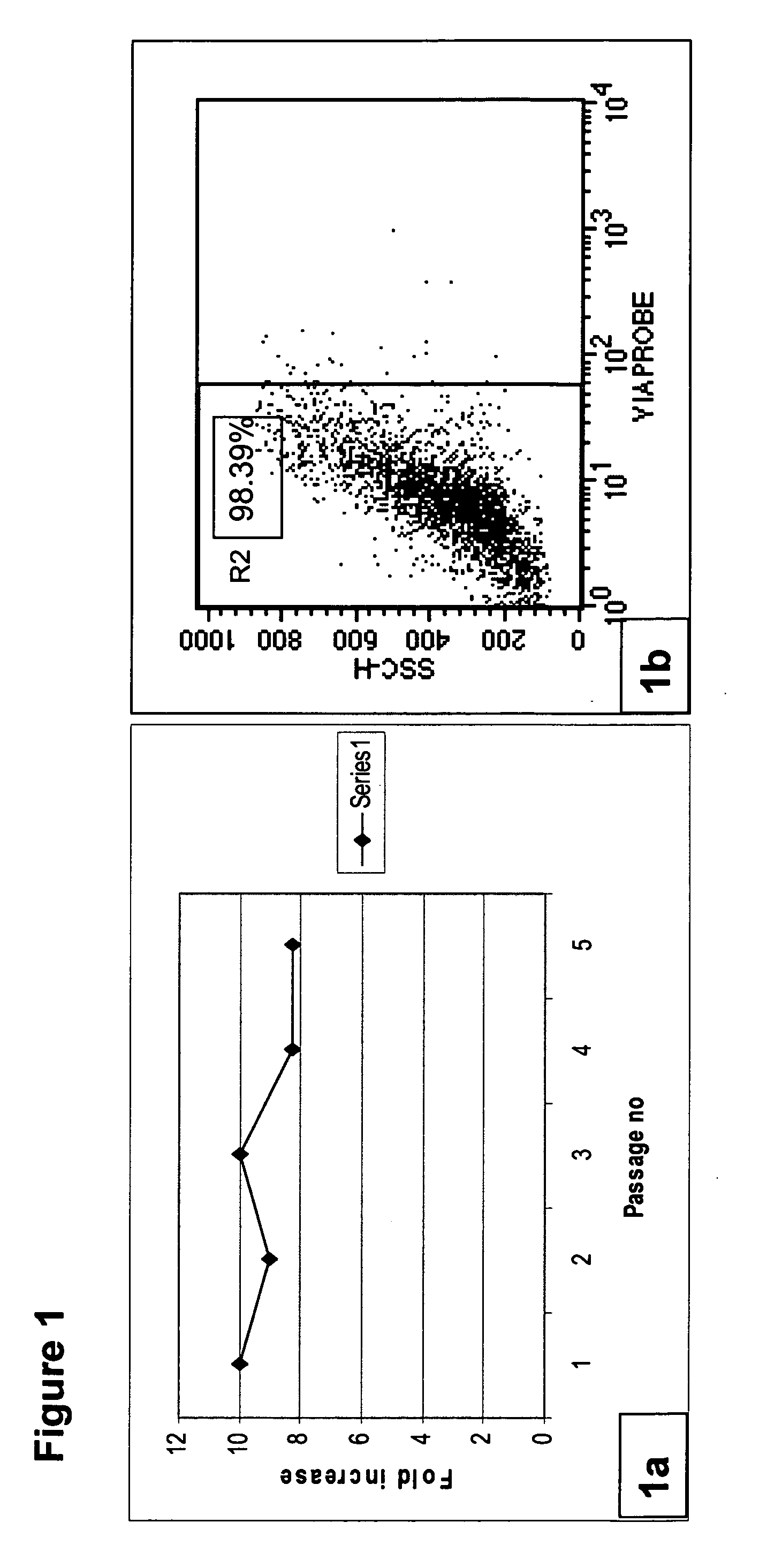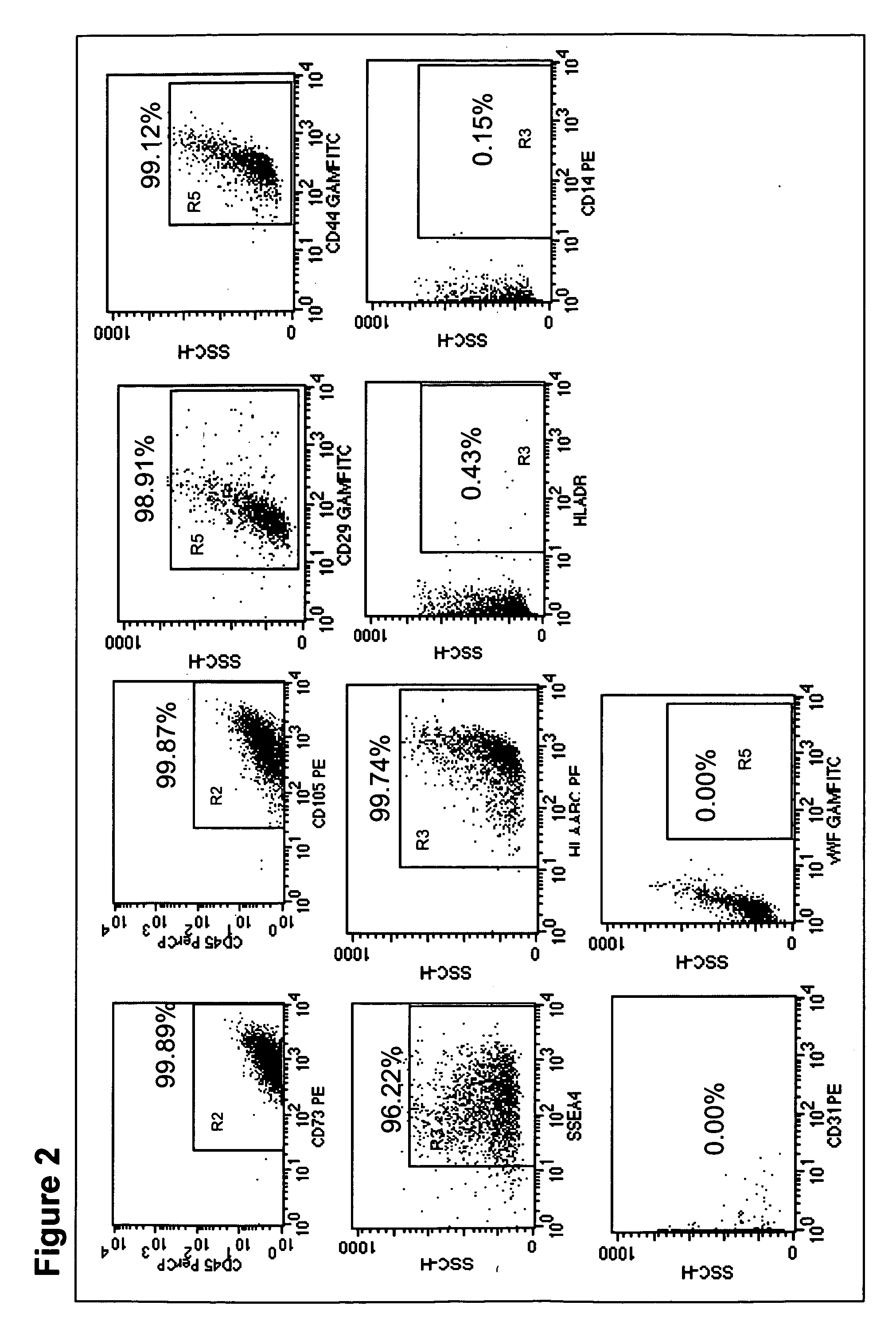Method of growing mesenchymal stem cells from bone marrow
a mesenchymal stem cell and bone marrow technology, applied in the direction of skeletal/connective tissue cells, nerve system cells, biochemistry apparatus and processes, etc., can solve the problem that the culture conditions developed for swine msc may not necessarily be applicable to human ms
- Summary
- Abstract
- Description
- Claims
- Application Information
AI Technical Summary
Benefits of technology
Problems solved by technology
Method used
Image
Examples
example 1
Isolation and Expansion of MSC in the Presence of CBS
[0230]Human bone marrow from normal volunteers was obtained from the iliac crest after an informed consenting process. The marrow was processed in a clean room environment. Mononuclear cells (MNCs) were isolated as reported earlier [25]. The isolated cells were seeded in 75-cm2 tissue culture flasks (Nunc, USA) in MSC proliferation medium containing DMEM: F12 (1:1) (Invitrogen, Singapore) supplemented with 10% CBS and 1 ng / ml of basic fibroblast growth factor (Sigma, USA), incubated at 37° C. with 5% CO2. The cells grew as colonies, which then became confluent to form a monolayer. Upon reaching confluency, the cells were harvested using trypsin EDTA (Invitrogen, Singapore) to give a single cell suspension. The harvested cells were analyzed for cell surface markers by flow cytometry (BD Pharmingen, USA).
[0231]Results
[0232]MSCs obtained from human bone marrow were successfully cultured and expanded in medium containing CBS under cGM...
example 2
Identification of BMMSC Phenotype
[0233]Immunophenotyping of the cultured MSCs were done using flow cytometry. The adherent cells were washed with PBS and detached by incubating with 0.05% trypsin EDTA (Invitrogen, Singapore) for 5 minutes at 37° C. The harvested cells were washed using staining buffer containing 4% FBS and 0.1% azide in PBS. After harvesting the adherent cells, a cell count was taken and approximately 50,000 cells were used for cell surface antigen expression studies. Cells were incubated with CD45 PerCP (BD Pharmingen, USA), CD73 PE (BD Pharmingen, USA), CD 105 PE (Caltag), SSEA4 PE (R&D systems, USA), HLADR PE (BD Pharmingen, USA), HLAABC PE (BD Pharmingen, USA), CD14 PE (BD Pharmingen, USA), CD31 PE (BD Pharmingen, USA), CD29 (BD Pharmingen, USA), CD44 (BD Pharmingen, USA), vWF (Santacruz, USA) using standard techniques [24]. Goat anti mouse FITC was used as a secondary antibody to detect the vWF primary antibody. Appropriate isotype controls were used. These cel...
example 3
Neural Differentiation of MSC Cultured in CBS
[0234]For inducing the neuronal differentiation, a modified version of Woodbury et al., protocol was followed. Briefly, after 3 days of expansion in MSC proliferation medium, the MSCs were pre induced in DMEM: F12 (1:1) medium (Invitrogen, Singapore) containingl 0% CBS, 2% B27 (Sigma, USA) and supplemented with growth factors 2 ng / ml basic fibroblast growth factor (Sigma, USA), 100 ng / ml nerve growth factor, 50 ng / ml of Noggin (Peprotech, USA). The cells were maintained in neuronal pre induction medium for a week with media changes affected every alternate day. After a week, the cells were induced with 200 μM BHA (Sigma, USA) in the same media for 4-5 hours to adapt the dopaminergic fate. Differentiated cells were characterized for the expression of neuron specific markers by immunoflourescence and RT-PCR. For characterization studies the expanded cells were plated in 8 well chamber slides (BD Falcon, USA) at a density of 3000 cells per w...
PUM
| Property | Measurement | Unit |
|---|---|---|
| flow rate | aaaaa | aaaaa |
| plasticity | aaaaa | aaaaa |
| stability | aaaaa | aaaaa |
Abstract
Description
Claims
Application Information
 Login to View More
Login to View More - R&D
- Intellectual Property
- Life Sciences
- Materials
- Tech Scout
- Unparalleled Data Quality
- Higher Quality Content
- 60% Fewer Hallucinations
Browse by: Latest US Patents, China's latest patents, Technical Efficacy Thesaurus, Application Domain, Technology Topic, Popular Technical Reports.
© 2025 PatSnap. All rights reserved.Legal|Privacy policy|Modern Slavery Act Transparency Statement|Sitemap|About US| Contact US: help@patsnap.com



